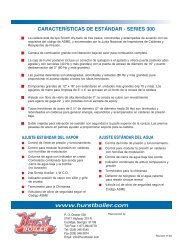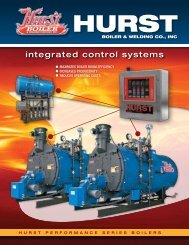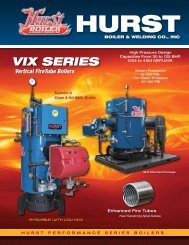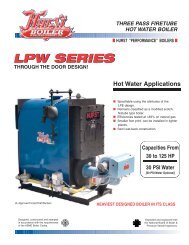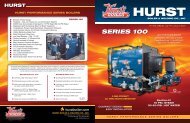Component & System Guide - Hurst Boiler
Component & System Guide - Hurst Boiler
Component & System Guide - Hurst Boiler
You also want an ePaper? Increase the reach of your titles
YUMPU automatically turns print PDFs into web optimized ePapers that Google loves.
H U R S T B O I L E R S E R I E S “ M H ”<br />
by the boiler’s working steam header pressure (or water temperature) --- as the header<br />
pressure drops the metering screw speeds up and as the pressure increases the speed<br />
reduces. While direct speed control of the screw is handled by the variable hertz drive,<br />
the drive itself is controlled by a Honeywell Universal Digital Controller (UDC), a<br />
microprocessor-based stand alone controller or the PLC, that not only controls the<br />
speed of the unit but also the rate of speed increase up to its 100% setting and its rate<br />
of descent. As the boiler header pressure drops off, the UDC determines the rate of<br />
drop off and activates the variable hertz drive accordingly --- a rapid drop off will cause<br />
the variable hertz drive to go to its 100% setting quickly. Conversely, as the pressure<br />
approaches the operator specified, boiler pressure set point, the UDC will gradually<br />
slow the drive down to avoid over feeding and allow for a more controllable output.<br />
This is also known as fully modulating fuel feed, as opposed to the older technologies<br />
available that offer only on-off operation. This HBC modulating control allows for feed<br />
control with minimum adjustment and provides the operator the opportunity to alter<br />
the speed based on changing conditions such as fuel quality. A dryer fuel will meet the<br />
systems needs with less poundage. For a more detailed description of the control<br />
parameters see “<strong>System</strong> Controls”.<br />
A HBC rotary air lock or fuel “plug” (created using advanced screw design) then acts as<br />
a “draft barrier”, allowing fuel to pass from the metering screw to the stoker screw<br />
while limiting the intrusion of air through the fuel system. If applicable, an air lock is<br />
provided and driven by a 3 or 5 HP, depending on application, constant speed motor.<br />
The air lock motor, through a sprocket and chain connection, also drives the stoker<br />
screw. These components may be eliminated with the use of HBC’s fuel “plug”<br />
technology.<br />
Finally, we’ve come to the stokers. Stokers are the heart of all biomass systems. They<br />
come in every form that man can contemplate. They may be in mechanically round,<br />
flat, inclined, reciprocating, fluidized or rotating forms, stationary or moving, or even<br />
pneumatic. All these designs have advantages and disadvantages, both economically<br />
and mechanically. After exhaustive research and experimentation, Gene <strong>Hurst</strong> decided<br />
that HBC should endeavor to build only those stoker designs that offered the absolute<br />
best of all worlds in economy, proven technology and adaptability.<br />
The five stoker designs that <strong>Hurst</strong> <strong>Boiler</strong> Co. manufactures, the HBC Stationary<br />
Pinhole, the HBC Pneumatic, the HBC Underfeed and the HBC Automatic Biomass<br />
and Coal Deashing, are economical, mechanically proven and adaptable for a wide<br />
range of fuels. Each stoker system design has specific applications where their best<br />
attributes are magnified to your greatest advantage.<br />
The HBC Stationary Pinhole Stoker <strong>System</strong> is designed for manual feeding of solid<br />
fuels. This system is typically applied to the smallest of boiler designs in applications<br />
where labor costs are not a factor. The gasification chamber’s floor is constructed of an<br />
under fire air plenum, support steel and multiple pinhole grates (12” x 6”) specifically<br />
5



